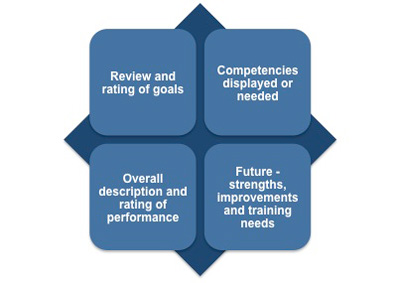Writing an Annual Performance Summary
As far as you as a manager are concerned, the primary purpose of the annual performance summary is to give the team member constructive feedback on how well they have performed over the period. The fact that is usually kept on file and forms part of the individual's personnel record is of secondary importance, as it will probably never be looked at again after it has been filed away.
 |
Ideally, a performance summary should consist of four sections:
- Goals - a description of how well each goal has been performed against its measure, and then a rating of this performance.
- Competencies - using the role description highlight from your observations and any significant incidents examples of where new competencies and improved or poor behavior have been displayed.
- Overall Performance - describe the individual's overall performance and the overall rating they have been awarded.
- Future - describe the person's strengths and areas of improvement, indicating potential training needs. You would summarize any disciplinary or HR issues in this section.
If your organization uses a standard appraisal form on which these areas are not obvious then you should think about preparing a supplementary sheet with these titles to use as an 'agenda' in the appraisal meeting with the team member. This will provide you with a useful and practical basis for the meeting rather than using the 'official' form. Obviously the 'official' form will still need to be signed and filed, but there is no reason to use it as the basis for the meeting if it is unsuitable.
When completing the competency section, there is no need to work through every competency listed in the role description. It is sufficient to highlight areas where an individual has developed their competencies and areas where these have fallen short of the requirements of the role.
When completing the overall performance section, you do not need to reiterate the content of the goal section unless you want to highlight exceptional or poor performance.
When completing the future section, you may want to refer to the type of training you wish them to undertake so that they can see how they can attain these new skills and behaviors. It is important that you build on successes as this will help to ensure that the individual stays motivated.
The initial written summary that you send to the individual a few weeks prior to the appraisal meeting must present your reasoning supported by objective data. The easiest way to ensure your summary meets this requirement is to use objective language that shows your impartiality and fairness.
Using objective language means choosing words that will be interpreted similarly by most people. It is most effective when it has a direct correlation with the duties and tasks for which the employee is responsible.
Some examples of objective phrases are:
Achieves results cost-effectively
Shows considerable analytical skills
Whilst the goal has been attained it has been achieved at the expense of accuracy
Decisions are communicated with confidence
Displays respect when presenting a counter-argument
Excels in resolving conflicts amongst peers
Show inconsistency in punctuality and attendance
Fails to attain expectations of the role
Displays an inability to multi-task
Easily grasps new concepts
Keeps accurate records
Maximizes use of time
Sets high standards for themselves and others
By using objective language you set an open and honest atmosphere for the appraisal meeting. Similarly, every time you refer back to the role description and its responsibilities or refer to supporting evidence you demonstrate that you have evaluated their performance fairly.
Remember, a successful performance management process demonstrates consistency and uniformity so that everyone knows that they have been appraised using the same standards.
You may also be interested in:
Evaluating Performance Appraisal | Appraisal Data Collection | Evaluating Competencies | Performance Appraisal Rating Bias | Performance Appraisal Rating Scales | Performance Appraisal Reviews.



